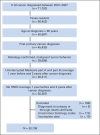Patterns and predictors of unplanned hospitalization in a population-based cohort of elderly patients with GI cancer
- PMID: 25287830
- PMCID: PMC4209103
- DOI: 10.1200/JCO.2014.55.3131
Patterns and predictors of unplanned hospitalization in a population-based cohort of elderly patients with GI cancer
Abstract
Purpose: Hospitalizations among patients with cancer are common and costly and, if unplanned, may interrupt oncologic treatment. The rate of unplanned hospitalizations in the population of elderly patients with cancer is unknown. We sought to describe and quantify patterns and risk factors for early unplanned hospitalization among elderly patients with GI cancer.
Patients and methods: We conducted a retrospective cohort study using linked Texas Cancer Registry and Medicare claims data from 2001 to 2009. Texas residents age 66 years or older initially diagnosed with GI cancer between 2001 and 2007 were included in the study. The unplanned hospitalization rate was estimated, and reasons for unplanned hospitalization were evaluated. Risk factors were identified using adjusted Cox proportional hazards modeling.
Results: Thirty thousand one hundred ninety-nine patients were included in our study, 59% of whom had one or more unplanned hospitalizations. Of 60,837 inpatient claims, 58% were unplanned. The rate of unplanned hospitalization was 93 events per 100 person-years. The most common reasons for unplanned hospitalization were fluid and electrolyte disorders, intestinal obstruction, and pneumonia. Multivariable analysis showed that black race; residing in census tracts with poverty levels greater than 13.3%; esophageal, gastric, and pancreatic cancer; advanced disease stage; high Charlson comorbidity index score; and dual eligibility for Medicare and Medicaid increased the risk for unplanned hospitalization (all P values < .05).
Conclusion: Unplanned hospitalizations among elderly patients with GI cancer are common. Some of the top reasons for unplanned hospitalization are potentially preventable, suggesting that comorbidity management and close coordination among involved health care providers should be promoted.
© 2014 by American Society of Clinical Oncology.
Conflict of interest statement
Authors' disclosures of potential conflicts of interest and author contributions are found at the end of this article.
Figures


References
-
- Institute of Medicine. Washington, DC: National Academies Press; 2013. Delivering High-Quality Cancer Care: Charting a New Course for a System in Crisis. - PubMed
-
- Yabroff KR, Lamont EB, Mariotto A, et al. Cost of care for elderly cancer patients in the United States. J Natl Cancer Inst. 2008;100:630–641. - PubMed
-
- Anhang Price R, Stranges E, Elixhauser A. Rockville, MD: Agency for Healthcare Research and Quality; 2012. Healthcare Cost and Utilization Project Statistical Brief No. 125: Cancer hospitalizations for adults, 2009. - PubMed
Publication types
MeSH terms
Grants and funding
LinkOut - more resources
Full Text Sources
Other Literature Sources
Medical

